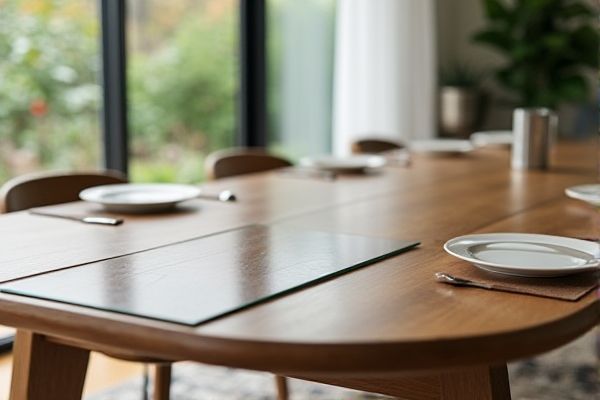
Glass table tops offer a sleek, modern aesthetic and are easy to clean, while wood table tops provide warmth, durability, and a classic appeal that can age beautifully over time. Discover the key differences and benefits of each to determine which material best suits your style and functional needs.
Table of Comparison
| Feature | Glass Table Top | Wood Table Top |
|---|---|---|
| Appearance | Modern, sleek, transparent | Warm, natural, classic |
| Durability | Scratch-resistant but can chip or crack | Strong, can dent or scratch but repairable |
| Maintenance | Easy to clean, needs regular wiping | Requires polishing and protection from moisture |
| Weight | Heavier, fragile to impact | Generally lighter, sturdier |
| Cost | Higher initial cost | Varies widely, often more affordable |
| Heat Resistance | Good, but sudden changes can cause cracking | Moderate, can be damaged by heat or spills |
| Customization | Limited shapes and colors | Highly customizable with stains and finishes |
| Environmental Impact | Non-biodegradable, recyclable glass | Renewable, biodegradable, depends on wood source |
Introduction: Comparing Glass and Wood Table Tops
Glass table tops offer a sleek, modern aesthetic with exceptional durability and resistance to stains and heat, making them ideal for contemporary interiors. Wood table tops provide natural warmth, unique grain patterns, and versatility in design, contributing to a cozy and timeless atmosphere. Both materials vary in maintenance needs, with glass requiring frequent cleaning for clarity and wood benefiting from periodic sealing to prevent damage.
Aesthetic Appeal: Glass vs Wood Styles
Glass table tops offer a sleek, modern aesthetic with a reflective surface that enhances light and creates an airy, spacious feel, making them ideal for contemporary interiors. Wood table tops provide warmth and natural texture, featuring grains and tones that vary by species such as oak, walnut, or maple, contributing to a timeless, rustic, or traditional look. Both materials cater to different style preferences, with glass emphasizing minimalism and transparency, while wood highlights organic beauty and craftsmanship.
Durability and Longevity
Glass table tops offer high resistance to scratches and stains, making them durable for daily use, but they can be prone to chipping or cracking upon impact. Wood table tops, especially hardwood varieties like oak or maple, provide exceptional longevity with proper care, developing a rich patina over time while being more susceptible to scratches and moisture damage. Your choice between glass and wood table tops should consider your lifestyle and how much wear and tear your furniture will endure.
Maintenance and Cleaning Requirements
Glass table tops require minimal maintenance, needing only regular wiping with a glass cleaner or a damp cloth to remove smudges and fingerprints, making them highly resistant to stains and water damage. Wood table tops demand more careful maintenance, including periodic polishing or oiling to prevent drying and cracking, along with immediate cleaning of spills to avoid stains and warping. Your choice hinges on whether you prefer the low-maintenance durability of glass or the warm, natural upkeep needed for wood surfaces.
Cost Comparison: Glass vs Wood Table Tops
Glass table tops generally have a higher initial cost compared to wood due to the manufacturing process and materials used, with prices ranging from $100 to $500 depending on thickness and design. Wood table tops vary widely in price based on the type of wood, with common hardwood options like oak or maple costing between $150 and $400, making hardwood a sometimes more cost-effective choice. Maintenance and durability also influence long-term cost; glass requires frequent cleaning to avoid smudges but resists staining, while wood may need refinishing but can be more affordable to repair.
Safety Considerations and Child-Friendliness
Glass table tops pose higher safety risks due to their fragility and sharp edges, increasing the potential for cuts or breakage around children. Wood table tops offer a safer, more durable option with rounded edges and less risk of injury, making them child-friendly. Your choice should prioritize impact resistance and edge smoothness to ensure a safe environment for kids.
Versatility and Suitability for Different Spaces
Glass table tops offer sleek, modern versatility ideal for small or contemporary spaces due to their light-reflecting properties and transparency, which create an open and airy atmosphere. Wood table tops provide warmth and adaptability, fitting effortlessly into rustic, traditional, or eclectic interiors, with various finishes enhancing their suitability for both formal dining rooms and casual living areas. Choosing between glass and wood hinges on spatial needs and design goals, where glass maximizes light and space perception while wood adds texture and depth to diverse environments.
Environmental Impact and Sustainability
Glass table tops have a lower environmental footprint due to their recyclability and durability, reducing the need for frequent replacements. Wood table tops, particularly those made from sustainably sourced or reclaimed timber, offer natural biodegradability and carbon sequestration benefits. Your choice can support sustainability by prioritizing materials with responsible sourcing and end-of-life recyclability.
Customization Options and Design Flexibility
Glass table tops offer extensive customization options such as tinted, frosted, or textured finishes, allowing for unique light transmission and modern aesthetics that complement various interior styles. Wood table tops provide greater design flexibility with an array of wood species, stains, and finishes that highlight natural grain patterns and offer warmth and character to any space. Custom wood can be easily shaped, carved, or inlaid, enabling intricate designs and personalized craftsmanship not achievable with glass.
Final Verdict: Choosing the Right Table Top for Your Needs
Glass table tops offer a sleek, modern aesthetic with easy maintenance and excellent resistance to heat and stains, making them ideal for contemporary spaces and households prioritizing cleanliness. Wood table tops provide warmth, durability, and a timeless appeal, often favored for their natural texture and ability to be refinished, perfect for those valuing a classic or rustic style. The right choice depends on your lifestyle, design preferences, and practical requirements, balancing the elegance and low upkeep of glass versus the cozy, enduring nature of wood.
 homyna.com
homyna.com